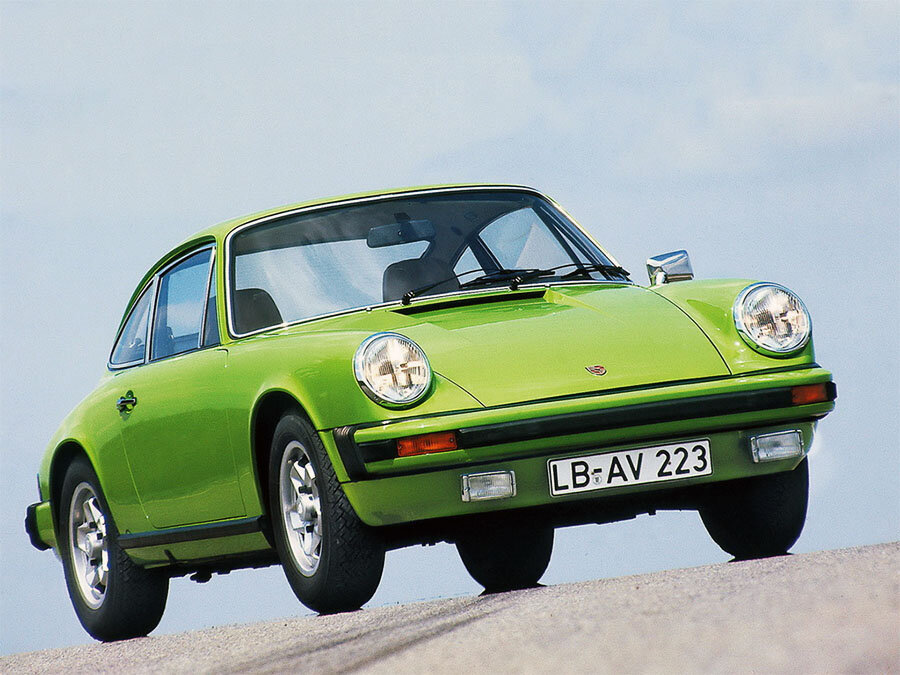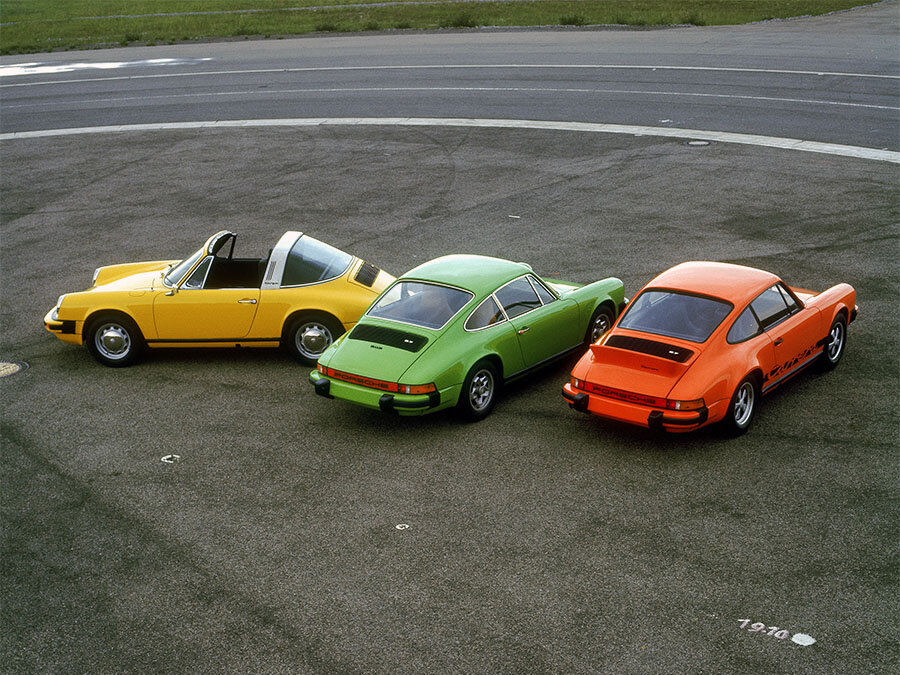Guide: Porsche 911 2.7 G & H-series (1974 & 75 Model Year) - a Historical & Technical Appraisal
/BACKGROUND
Porsche’s decision to replace the four cylinder 356 with the more expensive six cylinder 911 proved a great success; in the 911’s first nine years of production, nearly 83,000 were sold compared to 78,000 356s over a 17 year period.
Between 1964 and 1973, the first generation F-body 911 had been considerably improved. During this time, the engines used in series production variants grew from two to 2.4-litres.
For 1973, Porsche had also launched the venerable 2.7-litre Carrera RS; a limited production homologation special that spawned a successful RSR racing variant.
By the early 1970s, complying with tightening US safety and emission legislation was becoming a real headache for most high performance European manufacturers.
Fortunately, Porsche were in a financial position that enabled them to engineer a second generation 911. The resultant G-body platform would stay in production for the next 15 years and see the firm through some challenging times.
Production of the second generation 911 started in August 1973. The 1974 model year G-series derivative replaced the outgoing 1973 model year F-series.
Visually, the new 911 was given a major facelift and all three production variants now came with fuel-injected 2.7-litre engines. The entry level 911 had 150bhp, the mid-range 911 S offered 175bhp and the flagship 911 Carrera came with 210bhp.
Once again, customers were given the choice of either Coupe or Targa body styles.
In addition to the series production variants, Porsche also offered a G-series 911 Carrera RS complete with trick three-litre engine. These cars (covered separately) were built in tiny numbers to homologate an even more extreme 911 RSR racing car for the 1974 season.
CHASSIS
Although it looked quite different from the outside, the steel bodyshell used from the 1974 model year on actually changed relatively little. This was yet another testament to the original 911’s fundamentally good design.
As before, suspension was fully independent with torsion bars and telescopic shocks. The front end used a compact MacPherson strut arrangement with a single lower wishbone. At the rear, semi-trailing arms were installed.
For this latest application, the steel trailing arms were switched to lighter and stronger forged aluminium.
Thicker anti-roll bars were fitted than before: 16mm on the 911 and 911 S and 20mm / 18mm front to back on the 911 Carrera.
The top-of-the-range Carrera also came with gas-filled Bilstein shocks and bigger brake calipers. In addition, the first 200 or so featured flared rear wheelarches as per the 1973 RS.
Brakes were four-wheel ventilated discs and three different wheel styles were initially used. Standard equipment on the 911 and 911 S were 5.5 x 15-inch steel wheels with chromed hub caps. The Carrera used 16-inch Fuchs rims (6-inches wide front and 7-inches wide back).
6 x 15-inch ATS ‘Cookie Cutter’ rims were an option on the 911 and S.
A new 80-litre fuel tank shaped to accommodate the space saver wheel was installed under the front lid.
ENGINE / TRANSMISSION
Porsche’s new 2.7-litre engines were derived from that of the 1973 Carrera RS.
Compared to the 2.4-litre engines found in the outgoing line up, bore was taken out from 84mm to 90mm. Stroke remained unchanged at 70.4mm for a displacement of 2687cc.
Initially the same Nikasil-coated barrels from the Carrera RS were used, but they soon made way for Alusil components (a new aluminium silicon alloy).
These air-cooled, all-alloy Flat 6 motors ran a single overhead camshaft per bank and dry-sump lubrication.
They were available in three states of tune:
911: engine type 911/92, 150bhp at 5700rpm / 173lb-ft at 3800rpm, 8.0:1 compression ratio, Bosch K-Jetronic fuel-injection
911 S: engine type 911/93, 175bhp at 5800rpm / 173lb-ft at 4000rpm, 8.5:1 compression ratio, Bosch K-Jetronic fuel-injection
911 Carrera: engine type 911/83, 210bhp at 6300rpm / 188lb-ft at 5100rpm, 8.5:1 compression ratio, Bosch mechanical fuel-injection
The 911 and 911 S were both 10bhp up on the 911 T and 911 E that they replaced.
The engine in the 911 Carrera was identical to the unit found in the 1973 Carrera RS homologation special. It used mechanical fuel-injection instead of Bosch K-Jetronic.
A four speed Type 915/16 gearbox was standard throughput the range.
The five-speed Type 915/06 was an optional extra.
Both four and five-speed units came with longer ratios than before along with a 30% lighter clutch.
BODYWORK
Key to the second generation 911 was its new impact-absorbing bumpers.
Most manufacturers simply added ugly deformable black rubber appendages to their cars. By contrast, Porsche created a more elegant solution.
A body coloured bumper complete with black neoprene rubbing strip and matching bellows was mounted on collapsible steel tubes (or hydraulic shocks for US-bound examples).
New fenders, front lids and engine covers were required to accommodate the bumpers but the 911’s unmistakable profile remained.
Down each flank, a new body coloured side sill with integrated jacking point was mounted beneath a black rubbing strip.
The tail lights were carried over but now came with a neat red Porsche-branded reflector that linked them together.
Window frames and door handles were plated metal on the 911 and 911 S. Sometimes the side sills and headlights bezels were finished to match.
By contrast, the flagship 911 Carrera came with Porsche’s ‘Black Look’ which was an option on other variants. The ‘Black Look’ came with anodised black metal for the window frames, door handles and the rollover hoop on Targas.
Targas came with a removable roof panel that could be stowed under the front lid.
INTERIOR
Although the cockpit of this latest variant retained the same basic layout as before, there were myriad quality improvements.
New high-backed seats came with integrated headrests and inertia-reel seat belts. The brake pedal was lengthened for a lighter action and velour carpet was fitted throughout the range.
The 911’s familiar five gauge instrument layout was retained but the dash now came with soft-touch knobs, side window demisting vents, an electric tachometer and quartz clock.
Redesigned door panels featured an armrest that doubled up as a storage bin.
Manual windows and a four-spoke steering wheel were standard on the 911 and 911 S.
The 911 Carrera came with electric windows and a small diameter three-spoke steering wheel. It also featured opening rear quarter windows which were optional on the other models.
OPTIONS
Porsche offered a comprehensive list of extras to include: Koni dampers, bigger anti-roll bars, an oil cooler, a five-speed gearbox, metallic paint, fog lights, headlight washers, Black Look chrome delete, Porsche or Carrera wheelbase decals and the RS-style ‘Ducktail’ rear spoiler (outlawed in Germany on safety grounds).
Comfort options included full leather upholstery, Recaro sports seats, air-conditioning, tinted glass, a radio, electric antenna, heated rear window, rear wiper, electric windows, electric sunroof and electric mirrors.
Another optional extra available on the entry level 911 and 911 S was four-speed Sportomatic transmission which offered clutchless manual gear changing. When specified, engine type numbers became 911/97 for the 911 and 911/98 for the 911 S.
Sportomatic was not available on the flagship 911 Carrera.
USA VERSION / 911 2.7 CARRERA
The 911 Carrera was banned from the USA in its normal 210bhp configuration as the mechanical fuel-injection and radical valve timing did not meet Federal standards.
Instead, Porsche fitted US-bound Carreras with the 175bhp engine from the 911 S.
Changes made to American-spec. 911s over their rest of the world counterparts included extra sidelights, red tail lights and bumpers mounted on hydraulic shocks.
WEIGHT / PERFORMANCE
Thanks to some clever engineering, the weight of these second generation 911s was initially only 25kg up on the outgoing 2.4-litre variants.
In standard trim, they typically weighed in at around 1075kg (Coupe) and 1125kg (Targa).
Performance figures were as follows:
911: 131mph top speed, 0-62mph in 7.6 seconds
911 S: 139mph top speed, 0-62mph in 6.6 seconds
911 Carrera: 149mph top speed, 0-62mph in 6.1 seconds
OIL CRISIS
Production started in August 1973 but within a few months, the world was in the midst of an energy crisis.
Arab OPEC members announced an embargo on oil sales to the USA, UK, Canada, Japan and the Netherlands in response to the USA's support for Israel in the Yom Kippur War. Egypt and Syria, with the support of other Arab nations, had begun a military campaign to regain Arab territories lost during the 1967 Six Day War (when Egypt, Syria and Jordan had been the aggressors).
Oil prices rose exponentially and remained at elevated levels for the next two years.
Demand for gas guzzlers evaporated practically overnight. However, Porsche weathered the storm in remarkable fashion and sales figures were only slightly down on the previous year.
By contrast, some lower volume manufacturers went bankrupt and others struggled to survive.
END OF 1974 MODEL YEAR G-SERIES PRODUCTION
Just under 11,500 G-series 911s were constructed for the 1974 model year with production split as follows:
911 Coupe: 4014 / 911 Targa: 3110
911 S Coupe: 1359 / 911 S Targa: 898
911 Carrera Coupe: 1564 / 911 Targa: 433
1975 MODEL YEAR H-SERIES
In August 1974, Porsche began production of the 1975 model year H-series 911.
Universal upgrades included extra sound insulation and an additional heater fan.
Steel wheels were deleted from the range and 911 Carreras now came with body coloured headlight surrounds as standard.
The Ducktail rear spoiler option was dropped in favour of a new 3.0 Carrera RS-style Whale Tail. When this was specified, a discrete matt black chin spoiler was added at the front of the car.
The spoiler option pack was made standard on US-bound 911 Carreras which still came with the 175bhp 911 S engine rather than the rest of world 210bhp unit.
Although specifications remained the same, 911 and 911 S engines were given the following new type numbers for 1975.
911: from type 911/92 to 911/41 (from 911/97 to 911/46 if fitted with Sportomatic)
911 S: from type 911/93 to 911/42 (from 911/98 to 911/47 if fitted with Sportomatic)
Porsche dropped the entry level 911 from the US market and now offered American customers two types of de-tuned 911 S engine (which were also fitted to US-bound 911 Carreras):
911 S ‘49 State’: type 911/43 (911/48 if fitted with Sportomatic) 165bhp at 5800rpm, air pump fitted
911 S ‘California’: type 911/44 (911/49 if fitted with Sportomatic) 160bhp at 5800rpm, air pump fitted plus thermal reactors and exhaust gas re-circulation equipment.
911 / 911 S 25TH ANNIVERSARY
Porsche offered the 911 and 911 S in a special 25th Anniversary edition during the 1975 model year.
These very high specification cars came with Diamond Silver Metallic paint, Black-Look chrome delete, Fuchs wheels, a five-speed gearbox, special silver and black tweed trim, a three-spoke steering wheel from the Carrera, a numbered plaque on the passenger side of the dash, a thicker rear anti-roll bar, heated rear window, headlamp washers and a Blaupunkt Bamberg radio with electric antenna.
1063 were built.
END OF 1975 MODEL YEAR H-SERIES PRODUCTION
Production of the H-series 1975 model year 911 ended in July 1975.
From February of 1975, Porsche had also begun to build the 911 Turbo (930).
Normally aspirated production was down slightly on the previous year with just under 8000 units completed split as follows:
911 Coupe: 1238 / 911 Targa: 998
911 S Coupe: 2695 / 911 S Targa: 1783
911 Carrera Coupe: 518 / 911 Carrera Targa: 197 / 911 Carrera USA: 395
Text copyright: Supercar Nostalgia
Photo copyright: Porsche - https://www.porsche.com





































